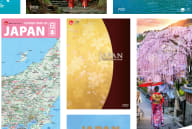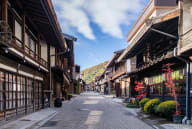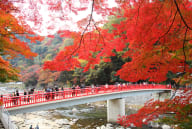
Kumamoto Where ancient charms meets modern allure
A Culinary Journey in Kumamoto
Kumamoto, nestled in the heart of the Kyushu region, is a prefecture celebrated for its rich cultural heritage, picturesque landscapes, and distinctive culinary traditions. Blessed with fertile plains and a mild climate, Kumamoto produces a variety of renowned agricultural products that are integral to its vibrant food scene.
One of Kumamoto’s most famous agricultural products is tomatoes, prized for their juiciness and rich flavour. The prefecture’s unique climate and soil conditions contribute to the superior quality of these tomatoes. Among the fruits, the Dekopon (a variety of satsuma orange) stands out as a symbol of Kumamoto’s agricultural excellence. This seedless citrus fruit, known for its easy-to-peel skin and exceptionally sweet and juicy flesh, has gained popularity in Japan and internationally. Kumamoto is also famous for Basashi (raw horse meat), which is thinly sliced and served raw as a delicacy. Horse meat is prepared in various traditional and modern dishes as well.
Kumamoto provides numerous opportunities to enjoy a meal while sightseeing. One of Japan's most impressive castles, Kumamoto Castle, is a historic site that frequently hosts local gourmet festivals and events, allowing you to savour local specialties in its surroundings. Nearby, Sakura no Baba Josaien recreates the castle town of the Edo period (1603 - 1868), adding to the immersive cultural experience.
From traditional dishes steeped in history to innovative creations that reflect modern influences, Kumamoto invites you to indulge in a culinary journey rich in taste and cultural significance.
Karashi Renkon (Lotus root with Japanese mustard)
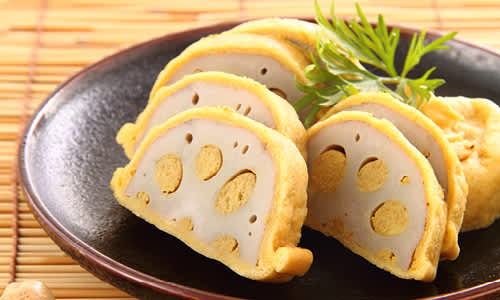
What it is (Ingredients)
Karashi Renkon, a beloved dish in Kumamoto, combines lotus root and Japanese mustard. The lotus root is typically sliced and stuffed with an aromatic mixture of Japanese mustard and miso paste, creating a unique blend of flavours and textures. It's then lightly coated in a batter and deep-fried, offering a crispy exterior that contrasts beautifully with the tender, flavourful filling.
History/Origin
Karashi Renkon dates back as far as the 16th century, when the Hosokawa clan invented it to utilize lotus roots that were abundant in the swampy terrain, leveraging their reputed blood-purifying properties for culinary delight. Over time, it evolved into a classic example of Kumamoto fare, beloved for its bold taste and cultural significance.
Where You Can Eat
While Karashi Renkon can be found in various specialty shops and restaurants throughout Kumamoto Prefecture, it's particularly popular in local eateries and markets in Kumamoto City and surrounding towns. You can enjoy this savoury treat in casual dining restaurants or explore specialty shops known for their artisanal approach to preparing local dishes.
When to Eat
Karashi Renkon is best relished during the cooler months of autumn and winter when lotus roots are particularly nutritious. Whether as a side dish, an hors d’ouevre, or a part of the main course, Karashi Renkon is a flavourful addition to any meal, offering a taste of Kumamoto's culinary heritage.
Karashi Renkon invites you to savour Kumamoto's unique flavours and cultural legacy. It is a must-try for anyone exploring the culinary delights of Japan.
Ikinari Dango (Sweet bean and sweet potato dumpling)
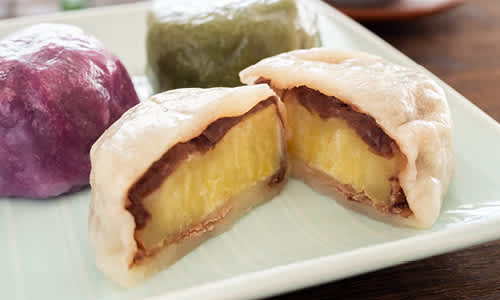
What it is (Ingredients)
Ikinari Dango is a traditional sweet from Kumamoto, featuring a delightful combination of sweet red bean paste and tender sweet potato encased in a soft, chewy rice flour dumpling. Variations may include different types of sweet potatoes or additional fillings like candied chestnut, offering a range of textures and flavours.
History/Origin
Embodying Kumamoto's rich agricultural heritage, Ikinari Dango dates back to the Edo period (1603 - 1868). Farmers crafted these treats as a portable snack using locally grown sweet potatoes and red beans. Over time, it became a beloved symbol of Kumamoto's culinary tradition, cherished for its comforting sweetness and cultural significance. While Ikinari Dango is traditionally enjoyed fresh, there are now options for "chilled Ikinari Dango" that can be eaten frozen or half-thawed.
Where You Can Eat
Ikinari Dango can be found at local confectioneries, street stalls, and specialty shops throughout Kumamoto Prefecture. Enjoyed fresh from the steamer or as a souvenir, these dumplings offer a taste of Kumamoto's unique culinary craftsmanship.
When to Eat
Best savoured during the autumn and winter when sweet potatoes are in season, Ikinari Dango provides a satisfying treat during chilly weather or as a delightful accompaniment to tea. Its rustic sweetness makes it a perfect indulgence any time of day.
Discover the charm of Ikinari Dango, where every bite encapsulates Kumamoto's agricultural bounty and cultural heritage.


















































